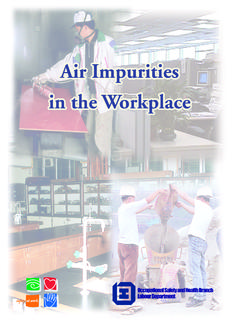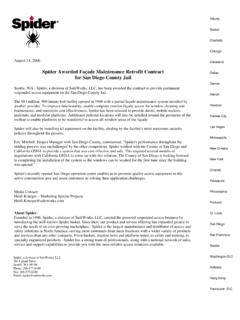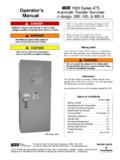Transcription of Window Washing/Suspended Maintenance Safety …
1 1 Vannoy & Associates 2004 Window Washing/Suspended Maintenance SafetyRegulations, Guidelines and Inspection RequirementsOccupational Safety And Health Administration (Osha) RegulationsPrior to October 25, 2001 the duties and responsibilities for owners of buildings to ensure thatthe health and Safety of all workers performing suspended Maintenance operations was solelyregulated by The Occupational Safety and Health Administration (OSHA). Suspendedmaintenance operations include Window cleaning, caulking, metal polishing, reglazing and generalmaintenance on building the OSHA Code of Federal Regulations, the subject of fall protection is covered by four mainstandards.
2 Part , Subpart D (Walking -Working Surfaces) Part , Subpart F (Powered Platforms) Appendix C to Part , Personal Fall Arrest System (Section I-Mandatory) Part , Subpart M (Fall Protection)OSHA enforces the issue of fall protection using the General Industry and Duty Clause, Section5(a)(1) of the OSH Act of 1970 and will support the enforcement by citing fall protectionrequirements using any one of the above labor standards contained in CFR 29 relating to fallarrest ANSI/IWCA Window Cleaning Safety StandardIn an effort to raise the standards for life Safety in the Window washing industry and develop aconsistent and comprehensive national Safety standard for Window cleaning operations, theInternational Window Cleaning Association (IWCA) has developed a Safety standard.
3 OnOctober 25, 2001, the American National Standards Institute (ANSI) approved the IWCA Cleaning Safety draft standard for publication as an American National intent of the ANSI/IWCA Window Cleaning Safety Standard is to provide minimumrequirements that are recommended for use by persons in the Window cleaning trade, personswho provide Window cleaning supplies or equipment to the trade and persons who employ orcontract Window cleaning contractors. One of the most important provisions of the I-14 Standardis that of shared responsibility between the Window cleaning contractor and the building ownerand/or their operating agent.
4 The Window cleaning contractor must provide the building owner2 Vannoy & Associates 2004with the assurance that all work will adhere to applicable codes, standards, laws and licensingrequirements; that their workers are properly trained; and that any equipment provided by thecontractor is properly designed, maintained and inspected. The building owner must provide thewindow cleaning contractor with the assurance that the installation of the structure has beeninspected, tested and maintained according to the Standard and that all equipment dedicated tothe building meets the requirements of the Standard.
5 Although OSHA regulations continue as the present governing regulations on suspendedmaintenance operations, the I-14 Standard includes and expands upon all of the OSHA regulations. Therefore, if a building is compliant with the I-14 Standard, the building is alsocompliant with OSHA regulations. The I-14 Standard recommends that: Window cleaning contractors and building owners and managers review the contents ofthe Standard as to how it affects each. Contractors should be aware of the worker srequirements and building owners and managers should be aware of the site mutual awareness should be developed within a year of the first publication of theStandard.
6 Final implementation of the methods, techniques and equipment described within theStandard should be accomplished in a period not to exceed 5 years from the date of firstpublication of the ANSI Standards do not have the force of law, they are cited in court as the standard ofcare any reasonable business would use in conducting its affairs. In addition, it is likely thatOSHA will review and adopt the standard, although in the meantime; OSHA can and willreference an industry standard if they uncover a dangerous situation at a workplace. Since the I-14 Standard is a standard that affects life Safety and may be used to identify potential liability,many building owners are wisely seeking full compliance with the new Inspection RequirementsBuilding owners of all installations, new and existing, where suspended scaffold, rope descentsystem (RDS) or similar single-point suspension equipment are to be used for suspendedmaintenance operations shall inform the Maintenance contractor that the suspended maintenanceinstallation (anchors, etc) has been inspected, tested (if necessary)
7 And maintained in compliancewith OSHA addition, all anchorages to which personal fall arrest equipment is attached shall be capable ofsupporting at least 5,000 pounds per employee attached, or shall be designed, installed, and used3 Vannoy & Associates 2004as part of a complete personal fall arrest system which maintains a Safety factor of at least two,under the supervision of a qualified regulations require that all anchor points and completed equipment installations beinspected by a competent person: Before being placed in initial service; Following any major alteration to an existing installation; At intervals not exceeding 12 months; At intervals specified by the manufacturer/supplier, but not exceeding 12 months ; and The building owner shall keep a certification record of each inspection and test certification record shall include the date of the inspection, the signature of theperson who performed the inspection, and the number, or other identifier, of the buildingsupport structure and equipment which was inspected.
8 This certification record shall bekept readily available for review by the Assistant Secretary of Labor or the AssistantSecretary s representative and by the to the approval of ANSI/IWCA , typical annual inspections of existing anchor pointsand completed equipment installations were commonly performed according to (g)(2)(ii) which requires that, All parts of the equipment including control systems shallbe inspected .. to determine that they are in safe operating condition . These annualinspections were typically performed under the assumption that the anchorages were initiallydesigned and inspected for compliance to applicable OSHA requirements.
9 The inspectionsconsisted of a visual condition assessment to determine that the anchorages had not worn to suchan extent as to affect the safe operation of the Inspection & Certification RequirementsThe ANSI/IWCA Standard contains inspection and certification requirements similar tothe OSHA regulations. However, as stated above, the ANSI/IWCA Standard includes andexpands upon the OSHA inspection requirements. The following inspection requirements forpermanently dedicated equipment are stated in the ANSI/IWCA Standard: Anchorages shall be certified before initial use and shall be provided with a rated load andinitial certification by the manufacturer; Anchorages shall be inspected annually by a qualified person; Anchorages shall be inspected at intervals specified by the manufacturer (not to exceed12 months); Anchorages shall be inspected by a competent person before each use.
10 4 Vannoy & Associates 2004 Anchorages shall be re-certified during re-roofing, renovating (pertinent to the windowcleaning system) or at periods not to exceed 10 years; Certification and re-certification of anchorages shall be performed under the supervisionof a registered professional engineer; and A record of all inspections and certifications shall be documented in a dedicated log ANSI/IWCA Standard requires the building owner to meet applicable inspectionprovisions of the Standard and to provide the following written assurances to the windowwashing contractor: The installation or structure has been inspected, tested and maintained in compliance withthe requirements of the Standard; Equipment dedicated to the building meets the requirements of Part B of the Standard; Specified load ratings, intended use and limitations for fixtures permanently dedicated tothe building.






